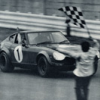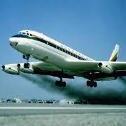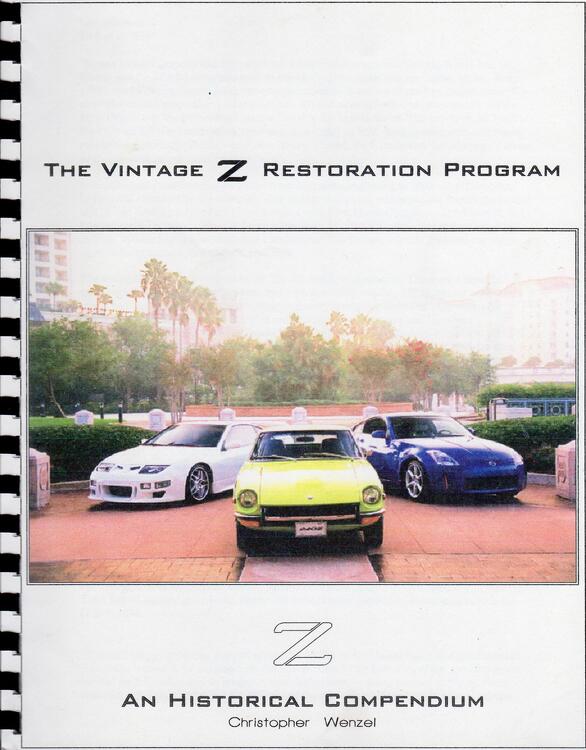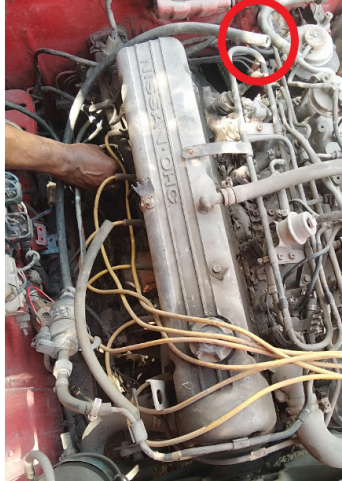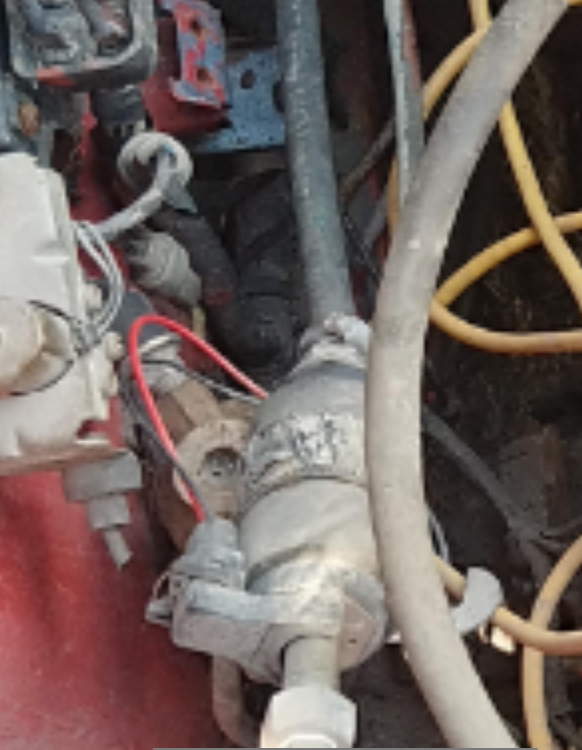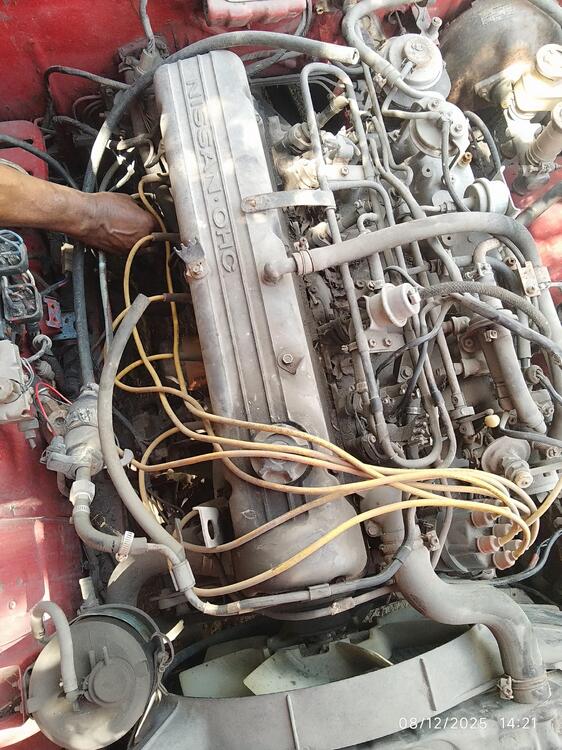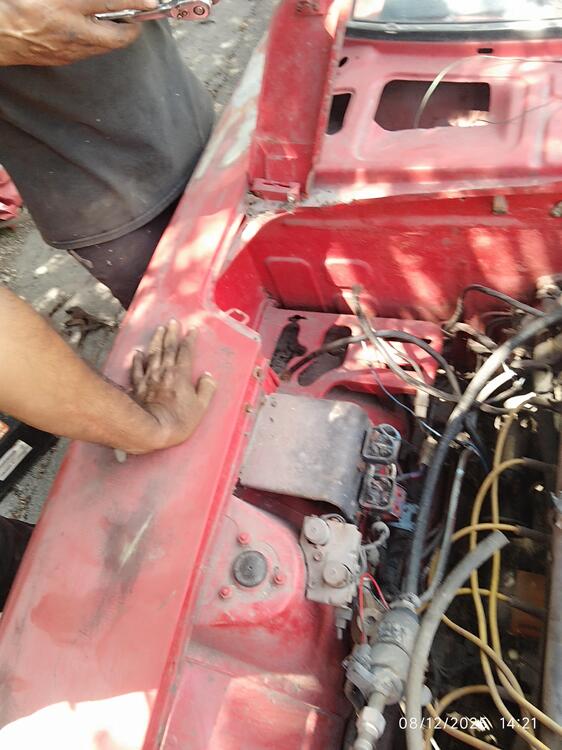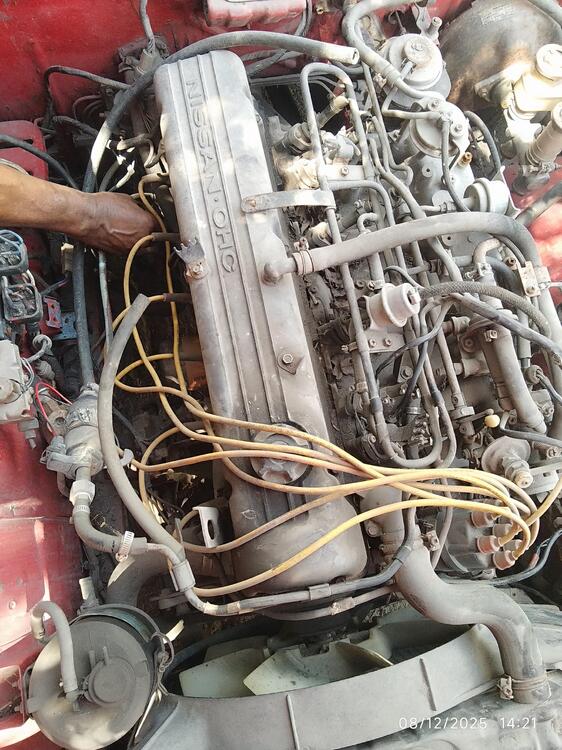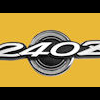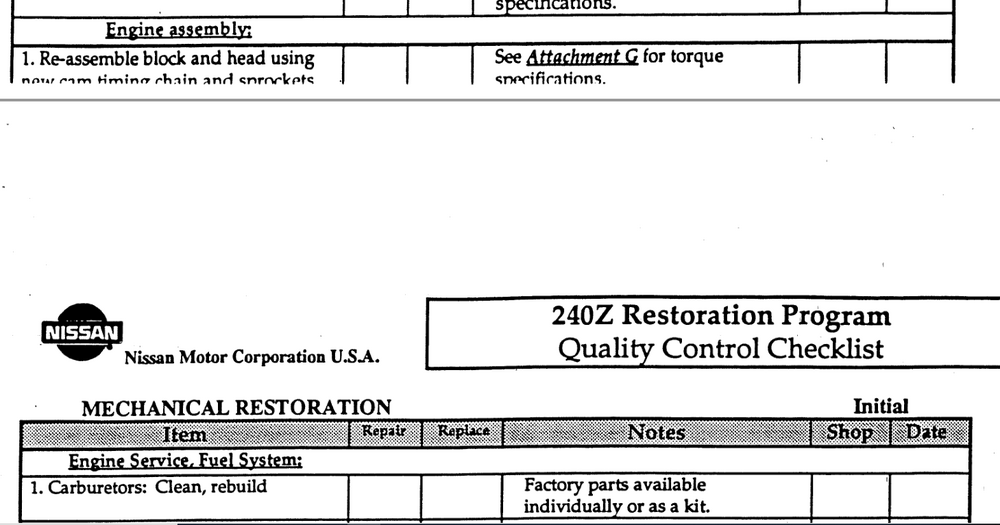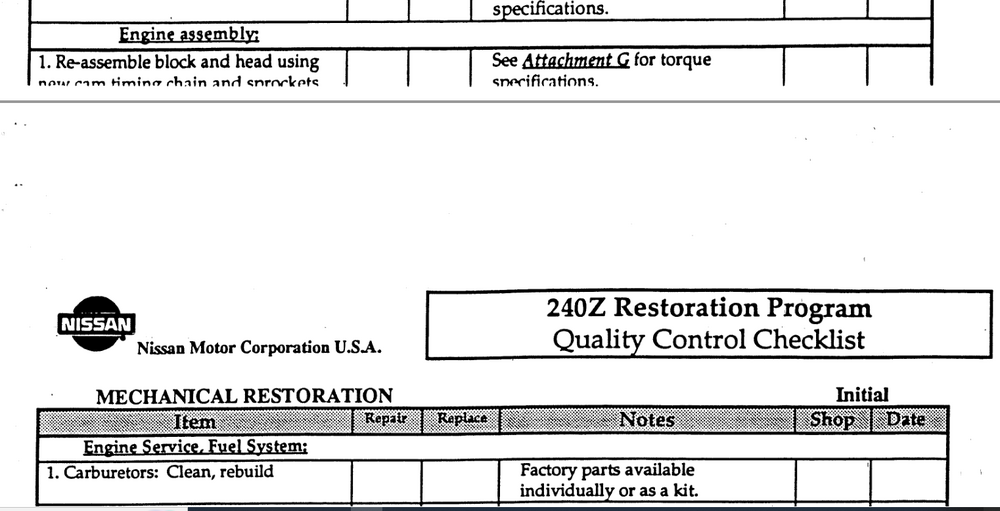All Activity
- Past hour
-
Z Restoration Progam
It also seems very likely that at least some of the components you describe as 'props' went into the restoration of the VZ Program cars, so they are pertinent. If we are discussing odds & probabilities, my bet is that many of them ended up on the cars in question.
-
Z Restoration Progam
It looks like the engine work was not as well-supervised as the body work. Only the Shop Representative signed off. As opposed to Body Restoration which required a Nissan Rep and a Shop Rep, and a Nissan Q.C. Engineer if there were questions. Still curious about the metal particles, if the engines came fully assembled.
-
Z Restoration Progam
As above, he's in Maine. I'm sure he'll comment when he returns.
-
Z Restoration Progam
Where can a copy be obtained, please advise. @26th-Z is it available as a digital download?
-
Z's on BAT and other places collection
I was never in the corporate world, but my wife is, and I think this is when she would ask the people in the meeting to take it off line.
-
Mitchel0407 started following 280Z in the Netherlands
-
280Z in the Netherlands
I may be late to the party but it’s great so see other Z owners from the Netherlands! I just bought my first Z last weekend. I bought a 1977 280z. @2-8E-Z I don’t know if you will answer but where did you get all your parts from? I’m kind of having problems locating European suppliers. I’m not afraid to order directly from the US but the import tariffs and taxes just add a lot of cost on top of the parts and shipping.
- Today
-
Mitchel0407 joined the community
-
Z Restoration Progam
As it's clear I don't know what I'm talking about this will be my last post to this subject. Cue the cheering throngs!
-
Carl Beck started following Z Restoration Progam
-
Z Restoration Progam
In the 10 months between 19 March 1997 and 16 Jan 1998 Nissan sent 42 engines to AER for remanufacture; they were all received by Nissan as of 12 May 1998. When they were received by Pierre, they were assembled and hot tested, before installation. What did assembled - mean? To assemble a remanufactured Long Block, you have to add everything outside of the block & head. Oil pump, water pump, fan, alternator, intake/exhaust systems, electrical components etc etc. It would be good to keep in mind that Pierre constantly “hosted” Photo Shots for Nissan PR/Ad. as well as all the magazine and news articles in period. In many photos you’ll see hundreds of new OEM parts laid out on the floor or benches for the Photo Shoots. Video’s as well - these "props” were left sitting all over the place. I wouldn’t try to determine any process based on staged prop’s sitting around the shop. @zspert wrote - “…...there was NO effort, none, to keep engines and transmissions with the cars from which they came.” If that was the case, then we are seeing an amazing statistical aberration. If 42 engines were sent out, then received - and no effort was given to return the original engines to the cars. The odds of any 1 car receiving its original engine would be 1 in 42 ie 0.024 or 2 in 100. What we actually see is, of the 35 VZ’s accounted for, 24 of them got their original engines,11 did not. 68% got their original engines.
-
hsmontacargas joined the community
-
Z Restoration Progam
-
Z Restoration Progam
No. Quite simply, I'm pointing out that "the engines were built by AER" is not the whole story. As was shown in the Pierre's shop photos - and has been related anecdotally - some engines were also rebuilt on-site (with machining likely done by contractors), so it's the usual case of story being more complex than bald statements - and VZ Program PR blurbs - can convey. This VZ Program engine build digression started because a VZ car owner asked about valve seats. It was you who made the suggestion - bizarrely, in my opinion - that the engines may not have been fully rebuilt, or even not rebuilt at all! I posted contemporary photos from Pierre's workshop which I hoped would help to contradict that and I think it's clear that the VZ cars would indeed have had proper engine rebuilds - one way or another - and yet, having made the suggestion of a lesser scenario (your 'alternator rebuild' simile), you don't own it. Where's your retraction? Now you've got another Straw Man scenario going where I'm somehow suggesting that "...Nissan engineers worked alongside AER employees or..." or, or, or. Where does this come from!? Where does that "Nissan engineers" quote come from? I haven't seen anybody make that suggestion. I and I'm sure many others appreciate your valued input on this forum - especially on technical matters, in which you use your expertise to help a lot of people solve issues they would otherwise be lost with - but you have a habit of complicating discussions on matters historical with alternate, hypothetical, if not totally imaginary scenarios. It doesn't make for good detective work.
-
Z's on BAT and other places collection
No. Quite simply, I'm pointing out that "the engines were built by AER" is not the whole story. As was shown in the Pierre's shop photos - and has been related anecdotally - some engines were also rebuilt on-site (with machining likely done by contractors), so it's the usual case of story being more complex than bald statements - and VZ Program PR blurbs - can convey. This VZ Program engine build digression started because a VZ car owner asked about valve seats. It was you who made the suggestion - bizarrely, in my opinion - that the engines may not have been fully rebuilt, or even not rebuilt at all! I posted contemporary photos from Pierre's workshop which I hoped would help to contradict that and I think it's clear that the VZ cars would indeed have had proper engine rebuilds - one way or another - and yet, having made the suggestion of a lesser scenario (your 'alternator rebuild' simile), you don't own it. Where's your retraction? Now you've got another Straw Man scenario going where I'm somehow suggesting that "...Nissan engineers worked alongside AER employees or..." or, or, or. Where does this come from!? Where does that "Nissan engineers" quote come from? I haven't seen anybody make that suggestion. I and I'm sure many others appreciate your valued input on this forum - especially on technical matters, in which you use your expertise to help a lot of people solve issues they would otherwise be lost with - but you have a habit of complicating discussions on matters historical with alternate, hypothetical, if not totally imaginary scenarios. It doesn't make for good detective work.
- Rare 240z Carpet clips. Set of 4
-
Z Restoration Progam
Did @26th-Z ever complete the document/booklet Chris was doing on the Vintage Z program? He mentioned it back in 2005!
-
It only works if I spray gas into the air intake.
- It only works if I spray gas into the air intake.
- It only works if I spray gas into the air intake.
That's a 1978 280Z. The fuel rail and other parts tell the story. Somebody has installed a fuel pump in the engine bay, and it is not connected a to a tank. of the type that don't like to pull fuel. That fuel pump should be moved back to the original area by the fuel tank (if it still works) so that it can self-prime with fuel. Download the FSM if you want to go deeper. https://www.classiczcars.com/files/category/13-280z/Alejandro started following It only works if I spray gas into the air intake.- It only works if I spray gas into the air intake.
Okay I have what my friend claims to be an 85 280z, he took the interior apart, but didn't disconnect the battery that was about a year ago and now the car won't start it's not a battery issue if I spray gas into the air intake it'll stay running but if I stop it dies. Here are some pics I was able to take today. I'm guessing the injectors aren't firing is there a relay? Something I might be overlooking? Any and I'll help is greatly appreciated.- Z Restoration Progam
@jfa.series1 Thanks so much...the PDF version is missing my particular vehicle (HLS30-68727), but it is very handy resource!- Yesterday
- Z Restoration Progam
Both of those links are variations of the Registry PDF I posted back in June. To the best of my recall, the version I posted is the original format that was active at the time I added my car. This version includes the original engine # where known and a column for replacement engine info. Because it was an active online spreadsheet a user could modify the report format to suit their taste. https://www.classiczcars.com/forums/topic/69433-2015-2020-online-registry-spreadsheet/#comment-676812- Z Restoration Progam
The Checklist document is interesting reading. There's a Nissan rep, and a Shop rep, and a QC Engineer, and an NRD Engineer. Not sure what NRD stands for, have to keep browsing. Also a National Service Center. Not sure where that is either.- Z's on BAT and other places collection
I posted my response above in 26th-Z's Restoration thread. That's a better place for the discussion. Let's see what happens. Click here folks if you want to continue the discussion.- Z Restoration Progam
Attempt to transfer Restoration program discussion over here from the BaT thread. It's an interesting discussion at its core. HS30-H seems to be implying that the engines were not rebuilt by AER, or maybe not all of them were. But he's not offering an alternative, unless he's saying that Nissan engineers worked alongside AER employees or received unassembled parts from AER or somewhere else. Rebuilding requires a machine shop. In 1996 I don't believe that Nissan had any manufacturing facilities in the States. They started assembling cars here in 1993. So, if it wasn't AER who was it? Where were those pictures taken? Seems unlikely that "Nissan engineers" were examining parts in the States. If they were, where did the parts come from? Also interested in where those metal fragments were seen in the AER engines. Under the valve cover? In the oil pan? Why were they seen if the engines arrived complete? Was AER just supplying short blocks and separate heads? The checklist implies that "The Shop" was to assemble the engines (pasted image below). Also implying that multiples machine shops might have been involved, each receiving instructions. Can't tell. These questions can be answered if we avoid the sidetracks. Interesting how Nissan is still using the 240Z in their marketing. First thing you see on their Heritage page. Nissan USANissan History: The Path from Datsun's Inception to TodayUncover the story of Nissan's heritage, including where Nissan started, when Datsun became Nissan, and the key dates that mark Nissan's evolution.- Z's on BAT and other places collection
Can we keep this thread on subject?- Z's on BAT and other places collection
It's an interesting discussion at its core. HS30-H seems to be implying that the engines were not rebuilt by AER, or maybe not all of them were. But he's not offering an alternative, unless he's saying that Nissan engineers worked alongside AER employees or received unassembled parts from AER or somewhere else. Rebuilding requires a machine shop. In 1996 I don't believe that Nissan had any manufacturing facilities in the States. They started assembling cars here in 1993. So, if it wasn't AER who was it? Where were those pictures taken? Seems unlikely that "Nissan engineers" were examining parts in the States. If they were, where did the parts come from? Also interested in where those metal fragments were seen in the AER engines. Under the valve cover? In the oil pan? Why were they seen if the engines arrived complete? Was AER just supplying short blocks and separate heads? The checklist implies that "The Shop" was to assemble the engines (pasted image below). Also implying that multiples machine shops might have been involved, each receiving instructions. Can't tell. These questions can be answered if we avoid the sidetracks. Interesting how Nissan is still using the 240Z in their marketing. First thing you see on their Heritage page. Nissan USANissan History: The Path from Datsun's Inception to TodayUncover the story of Nissan's heritage, including where Nissan started, when Datsun became Nissan, and the key dates that mark Nissan's evolution.- Z's on BAT and other places collection
Agree to Disagree and move on. This is not what I personally need to see.
Important Information
By using this site, you agree to our Privacy Policy and Guidelines. We have placed cookies on your device to help make this website better. You can adjust your cookie settings, otherwise we'll assume you're okay to continue.




